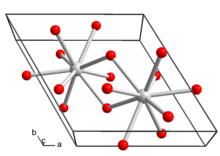 __ La __ OH | |
| Names | |
|---|---|
| IUPAC name Lanthanum(III) hydroxide | |
| Identifiers | |
| CAS Number | |
| 3D model (JSmol) | |
| ChemSpider | |
| ECHA InfoCard | 100.034.994 |
| EC Number |
|
| PubChem CID | |
| UNII | |
| CompTox Dashboard (EPA) | |
InChI
| |
SMILES
| |
| Properties | |
| Chemical formula | La(OH)3 |
| Molar mass | 189.93 g/mol |
| Solubility in water | Ksp= 2.00·10 |
| Structure | |
| Crystal structure | hexagonal |
| Space group | P63/m, No. 176 |
| Lattice constant | a = 6.547 Å, c = 3.854 Å |
| Hazards | |
| Occupational safety and health (OHS/OSH): | |
| Main hazards | Irritant |
| GHS labelling: | |
| Pictograms | 
|
| Signal word | Danger |
| Hazard statements | H314 |
| Precautionary statements | P260, P264, P280, P301+P330+P331, P303+P361+P353, P304+P340, P305+P351+P338, P310, P321, P363, P405, P501 |
| NFPA 704 (fire diamond) |
 |
| Flash point | Non-flammable |
| Related compounds | |
| Other anions | Lanthanum(III) chloride |
| Other cations | Cerium(III) hydroxide Actinium(III) hydroxide |
| Except where otherwise noted, data are given for materials in their standard state (at 25 °C , 100 kPa).
| |
Lanthanum hydroxide is La(OH)
3, a hydroxide of the rare-earth element lanthanum.
Synthesis
Lanthanum hydroxide can be obtained by adding an alkali such as ammonia to aqueous solutions of lanthanum salts such as lanthanum nitrate. This produces a gel-like precipitate that can then be dried in air.
- La(NO3)3 + 3 NH4OH → La(OH)3 + 3 NH4NO3
Alternatively, it can be produced by hydration reaction (addition of water) to lanthanum oxide.
- La2O3 + 3 H2O → 2 La(OH)3
Characteristics
Lanthanum hydroxide does not react much with alkaline substances, however is slightly soluble in acidic solution. In temperatures above 330 °C it decomposes into lanthanum oxide hydroxide (LaOOH), which upon further heating decomposes into lanthanum oxide (La2O3):
- La(OH)3 LaOOH
- 2 LaOOH La2O3
Lanthanum hydroxide crystallizes in the hexagonal crystal system. Each lanthanum ion in the crystal structure is surrounded by nine hydroxide ions in a tricapped trigonal prism.
References
- "C&L Inventory". echa.europa.eu.
- ^ E.V. Shkolnikov (2009). "Thermodynamic Characterization of the Amphoterism of Hydroxides and Oxides of Scandium Subgroup Elements in Aqueous Media". Russian Journal of Applied Chemistry. 82 (2): 2098–2104. doi:10.1134/S1070427209120040. S2CID 93220420.
- Ding, Jiawen; Wu, Yanli; Sun, Weili; Li, Yongxiu (2006). "Preparation of La(OH)3 and La2O3 with Rod Morphology by Simple Hydration of La2O3". Journal of Rare Earths. 24 (4): 440–442. doi:10.1016/S1002-0721(06)60139-7.
- Michael E. Brown, Patrick Kent Gallagher (2008). Handbook of Thermal Analysis and Calorimetry. Elsevier. p. 482. ISBN 978-0-44453123-0.
- Beall, G.W.; Milligan, W.O.; Wolcott, Herbert A. (1977). "Structural trends in the lanthanide trihydroxides". Journal of Inorganic and Nuclear Chemistry. 39 (1): 65–70. doi:10.1016/0022-1902(77)80434-X.
External links
- "Lanthanum - Element information, properties and uses - Periodic Table". rsc.org.
- External MSDS 1
- External MSDS 2
- Lanthanum Oxide MSDS
| Lanthanum compounds | |
|---|---|
| Hydroxides | ||||||||||||||||||||||||||||||||||||||||||||||||||||||||||||||||||||||||||||||||||||||||||||||||||||||||||||||||||||||||||||||||||||||||||||||||||||||||||||||||||||
|---|---|---|---|---|---|---|---|---|---|---|---|---|---|---|---|---|---|---|---|---|---|---|---|---|---|---|---|---|---|---|---|---|---|---|---|---|---|---|---|---|---|---|---|---|---|---|---|---|---|---|---|---|---|---|---|---|---|---|---|---|---|---|---|---|---|---|---|---|---|---|---|---|---|---|---|---|---|---|---|---|---|---|---|---|---|---|---|---|---|---|---|---|---|---|---|---|---|---|---|---|---|---|---|---|---|---|---|---|---|---|---|---|---|---|---|---|---|---|---|---|---|---|---|---|---|---|---|---|---|---|---|---|---|---|---|---|---|---|---|---|---|---|---|---|---|---|---|---|---|---|---|---|---|---|---|---|---|---|---|---|---|---|---|---|
| ||||||||||||||||||||||||||||||||||||||||||||||||||||||||||||||||||||||||||||||||||||||||||||||||||||||||||||||||||||||||||||||||||||||||||||||||||||||||||||||||||||
This inorganic compound–related article is a stub. You can help Misplaced Pages by expanding it. |
 LaOOH
LaOOH La2O3
La2O3